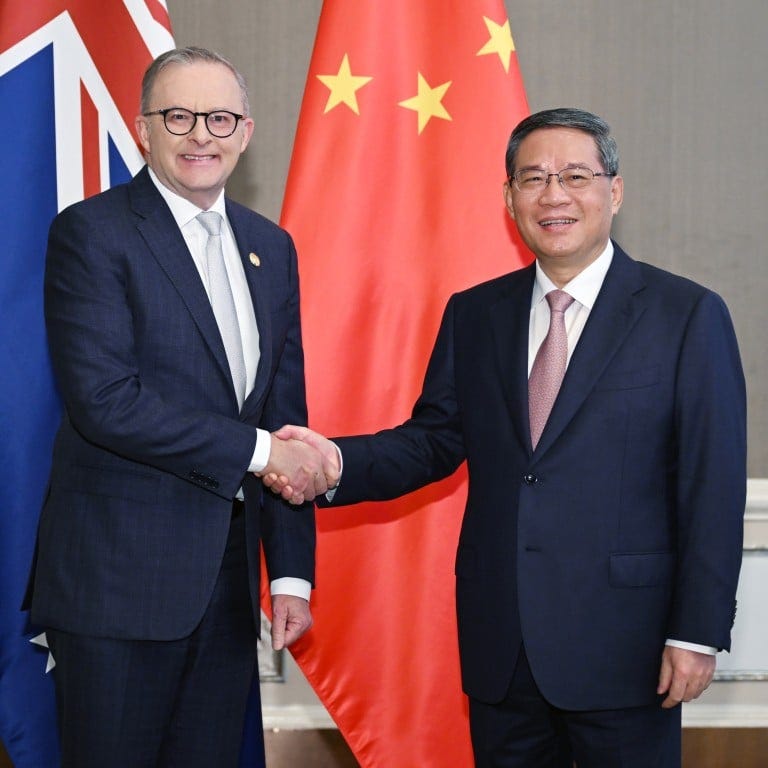As Chinese Premier Li Qiang embarks on his visit to Australia from June 15 to 18, 2023, the diplomatic landscape is poised for a pivotal shift. This high-stakes engagement, the first by a Chinese premier since 2017, carries the weight of years of strained relations and strategic competition between the two nations. Yet, it also represents a concerted effort to mend ties and explore avenues for cooperation, despite the underlying complexities and mutual skepticism.
Economic Interdependence and Trade Tensions
At the heart of the China-Australia relationship lies a paradoxical dynamic of economic interdependence and trade tensions. China remains Australia’s largest trading partner, with Australian resources and energy exports forming the backbone of this trade relationship. However, recent years have witnessed a series of disruptive trade barriers imposed by China, including restrictions on Australian barley, wine, and coal exports.
These measures were widely perceived as economic coercion, a response to Australia’s call for an independent investigation into the origins of COVID-19 — a move that deeply irked Beijing. While some of these barriers have been lifted, the ongoing ban on importing live lobsters from Australia remains a contentious issue, underscoring the fragility of their economic ties.
Premier Li Qiang’s visit aims to address these trade barriers and potentially pave the way for breakthroughs in economic cooperation. However, the underlying tensions and Australia’s efforts to diversify its trade partners, including strengthening ties with the United States, Japan, and India through initiatives like the Quad alliance, underscore the complex dynamics at play.
In historical context, China’s economic strategies have long involved leveraging trade relationships to exert soft power. Australia’s geographic proximity and trade volume make it a key player in the Asia-Pacific economic arena. Yet, Canberra’s strong stance on human rights and its alliance with Western democracies create a delicate balancing act. This visit must navigate these economic and diplomatic minefields.
Strategic Competition and the AUKUS Pact
Beyond the economic realm, the visit occurs amid ongoing strategic competition in the Asia-Pacific region. Australia’s alignment with the United States through the AUKUS security pact, which includes the sharing of nuclear submarine technology, has been a significant point of contention for China. Beijing views this pact as a direct threat to its regional influence and a manifestation of the broader U.S.-China rivalry.
While the visit aims to stabilize relations, the deep-seated strategic competition and mutual skepticism are unlikely to be resolved through a single diplomatic engagement. The AUKUS pact, coupled with Australia’s participation in the Quad alliance alongside the U.S., Japan, and India, has further strained ties with China, which perceives these alliances as tools to contain its rise.
Historically, such pacts echo the Cold War era’s alliances, where the USSR and the United States both formed strategic blocs. The AUKUS pact, initiated in 2021, particularly underscores a collective stance against perceived Chinese expansionism in the Indo-Pacific. Premier Li’s visit, therefore, is a test for China to diplomatically counterbalance this coalition without escalating tensions.
Symbolic Diplomacy and Humanitarian Concerns
Amidst the complex geopolitical dynamics, Premier Li Qiang’s visit also carries symbolic significance. The inclusion of “panda diplomacy,” with discussions on the future of Adelaide Zoo’s pandas, reflects China’s softer diplomatic approach and recognition of the importance of public perception in bilateral relations.
However, symbolic gestures alone are unlikely to address the broader concerns that underpin the strained relationship. Human rights issues, including China’s treatment of Uyghur Muslims and political dissidents, are expected to be part of the dialogue, reflecting the values-based differences between the two nations.
Symbolic diplomacy has historically been part of China’s toolkit in improving international relations. However, this runs parallel to substantive issues such as human rights, bringing to fore how international scrutiny affects bilateral ties. Australia, maintaining its stance on international human rights, has urged for transparency and change. Premier Li’s approach to addressing these will undoubtedly shape future dialogues.
Public Perception and Future Prospects
Public sentiment in Australia towards China is a crucial factor shaping the political discourse on bilateral relations. A recent poll indicates that Australians are wary of China’s government but recognize the importance of maintaining strong economic ties. This dichotomy reflects the delicate balance that Australian policymakers must strike in navigating this complex relationship.
The wariness is rooted in several high-profile incidents, from the influence of China’s Belt and Road Initiative to potential espionage threats. Public discourse often reflects a blend of economic pragmatism and national security concerns. The challenge for Australian leaders is to reconcile these viewpoints while engaging with China in constructive dialogue.
While the visit is expected to lay the groundwork for future engagements, addressing the deep-rooted strategic competition and ideological differences between China and Australia will require sustained diplomatic efforts and a willingness to engage on complex issues. The path forward is fraught with challenges, but also holds the potential for a more stable and cooperative relationship, if both sides can find common ground amidst their divergent interests.
Conclusion
Premier Li Qiang’s visit to Australia represents a pivotal moment in the evolving China-Australia relationship. It encapsulates the intricate web of economic interdependence, strategic competition, and ideological differences that have shaped the dynamics between the two nations. While the visit holds the potential for short-term progress in areas like trade and symbolic diplomacy, the underlying strategic competition and divergent interests suggest that a comprehensive resolution of bilateral tensions remains a formidable task requiring nuanced and sustained engagement.
As the world watches this diplomatic event unfold, it serves as a reminder of the complexities inherent in navigating the shifting geopolitical landscape of the Asia-Pacific region. The visit may mark a step towards stabilizing relations, but the true test lies in the ability of both nations to find common ground amidst their competing interests and forge a path towards a more stable and cooperative future.

